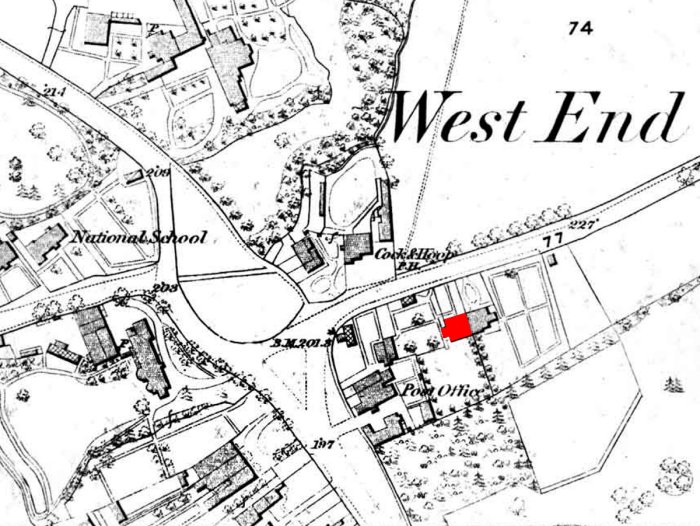Charles Dickens’ brother lived in West Hampstead
Alfred Lamert Dickens, Charles Dickens’ younger brother, was born in Chatham in April 1822, the son of John and Elizabeth Dickens. From February to May 1824 John Dickens was in the Marshalsea debtor’s prison, where he was joined by Elizabeth and the three youngest Dickens children including Alfred. At the time a debtor’s family could move in if they could afford to pay for a private room. Charles Dickens was sent to lodge in Camden Town.
Peter Ackroyd, in his excellent biography of Dickens, says that Alfred was the only one of Dickens’ siblings to make something of himself. Alfred became a civil engineer and during the 1840s, was engaged on the construction of the York, Malton and Scarborough Railway. He also engineered the Malton and Driffield Railway, which opened in 1853 and which eventually was amalgamated into the North Eastern Railway. Charles Dickens knew the village of Malton through his lifelong friendship with solicitor Charles Smithson, who lived there. It seems probable that Dickens helped his brother get his position with the railway companies.
In 1846, Alfred married Yorkshire-born Helen Dobson, who was a minor, at St Andrew’s Holborn. Between 1847 and 1853 they had four children, all born in Malton. Alfred had an office there in the Market Place, and lived at Hillside Cottage, Greengate, Malton and they later moved to Derwent Cottage, Scarborough Road, Norton.

Sketch of Alfred Lamert Dickens
His wife Helen and children were at Derwent Cottage on the night of the 1851 census, when she describes herself as an ‘engineer’s wife’. At the time Alfred was in London, at 34 Keppel Street, the house of a Dr Davey. His mother and father had been lodging there when John died on 31 March after a botched operation, a few days before the census was taken. Alfred had travelled to London to attend his father’s funeral at Highgate Cemetery.
Alfred and his family left Malton and came to live in London after the amalgamation of the railway lines in 1854. The birth of his daughter Augusta in Hampstead and his report on the sanitary conditions in Canning Town both date from 1855.
It’s likely that Alfred stayed in London but the family returned north. He used his civil engineering experience to become a Superintending Inspector appointed to administer the Public Health Act. In addition to the Canning Town report, he appears six times in the London Gazette between 1855 and 1857, where Alfred Lamerte (sic) Dickens is reported as visiting various districts to look at their sewerage, drainage, water supply and other public heath criteria, as preparatory work to establish a Local Board of Health. He visited Mistley and Brentwood in Essex, Bradford, Wheatley in Oxfordshire, Ynyscynhaiarn in Carnarvon and Scarborough in Yorkshire.
We know Alfred was living somewhere in Hampstead in 1855 when his daughter Augusta was born and that he was renting Lawn Cottage on West End Lane in 1859. This was one of a pair of houses on the Lane towards Finchley Road, uphill from West End Green. The whole area at the time was known as West End, not West Hampstead.

Lawn Cottage, 1865
Lawn Cottage (marked in red on the map) and Fern Cottages were opposite the Cock and Hoop pub.

Children on West End Green, about 1882. Lawn Cottage is in the background on the right
Peter Ackroyd says Alfred was working as an engineer in Manchester when he died of pleurisy on 27 July 1860. Alfred left a widow and five children. Charles Dickens provided for them. He confided to a close friend, ‘Day after day I have been scheming and contriving for them, and am still doing so, and have schemed myself into broken rest and low spirits.’
Charles brought Alfred’s family back to London for the funeral at Highgate Cemetery. The probate record shows that Alfred was still living at West End at the time of his death. It seems likely he was visiting Manchester and the fact that he died at a pub and hotel, the ‘Moseley Arms’, seems to corroborate this. He left less than £600, worth about £46,000 today.
A year later, Alfred’s widow Helen and the children were living with Charles Dickens’ widowed mother Elizabeth, at 4 Grafton Terrace in Kentish Town. Charles paid for the house and for Helen to look after his mother, who was suffering from dementia. Dickens wrote in a letter:
My mother, who was also left to me when my father died (I never had anything left to me but relations), is in the strangest state of mind from senile decay; and the impossibility of getting her to understand what is the matter combined with her desire to be got up in sables like a female Hamlet, illumines the dreary scene with a ghastly absurdity that is the chief relief I can find in it.
Elizabeth Dickens died in 1863. In 1871, Helen Dickens was living round the corner from Grafton Terrace in Queen’s Crescent. She died in 1915.
We were very surprised to find Dickens’ brother had lived in West End, if only for a short period of time before his death.
We have just set up a new blog for stories which are based in Kilburn and Willesden.


